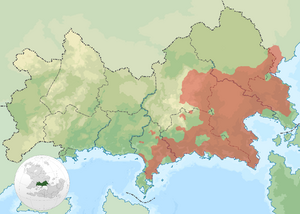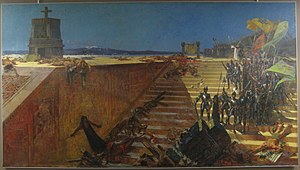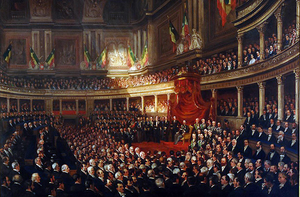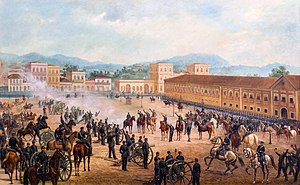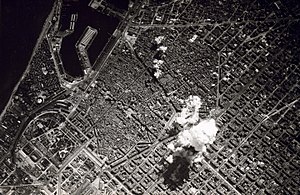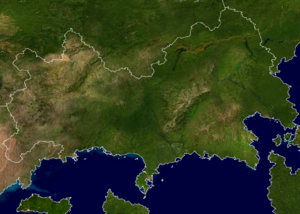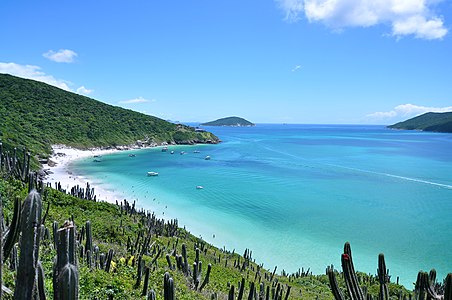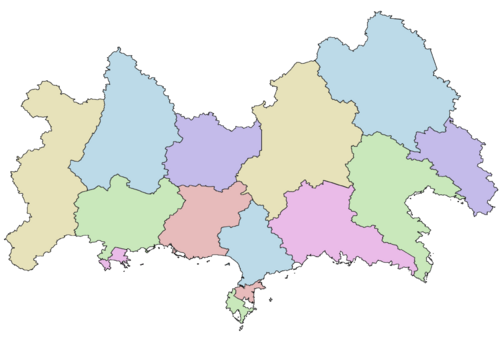Ardesia
This article is incomplete because it is pending further input from participants, or it is a work-in-progress by one author. Please comment on this article's talk page to share your input, comments and questions. Note: To contribute to this article, you may need to seek help from the author(s) of this page. |
Federative Republic of Ardesia República Federativa do Ardésia (Luzelese) | |
|---|---|
| Motto: "Unidade, Ordem, Progresso." "Unity, Order, Progess" | |
| Anthem: Hino do Ardése "Hymn of the Ardese" | |
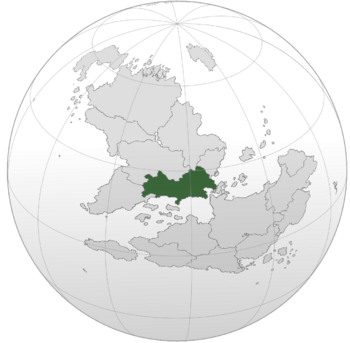 Location of Ardesia (dark green) in Asteria Superior | |
| Capital | Rémont (constitutional and legislative) São Agostinho (executive and judicial) |
| Official languages | Luzelese |
| Recognised regional languages | Zapoyan Vespasian |
| Ethnic groups (2020) | 44.12% White 31.88% Mixed 13.59% Black 9.41% Indigenous ~1% Other |
| Religion (2019) | 81% Sotirianity -87.2% Solarian Catholicism -12.8 Amendism 12% Irreligious 7% Indigenous Spiritism |
| Demonym(s) | Ardese, Ardesian |
| Government | Federal semi-presidential constitutional republic |
| Frédéric Ardila | |
| Anton Caetano | |
| Emanuel Joachim | |
| Legislature | Federal Assembly |
| Federal Senate | |
| Chamber of Deputies | |
| Area | |
• Total | 1,494,868 km2 (577,172 sq mi) |
• Water (%) | 1.4% |
| Population | |
• Estimate | 54,335,100 |
• Density | 22/km2 (57.0/sq mi) |
| GDP (PPP) | estimate |
• Per capita | $13,662 |
| GDP (nominal) | estimate |
• Per capita | $7,531 |
| Gini (2018) | 32.1 medium |
| HDI | 0.79 high |
| Currency | Ardesian real |
| Time zone | UTC +11 to +12, -12, -11 |
| Date format | dd/mm/yyyy |
| Driving side | right |
Ardesia (Luzelese: Ardésia; Ardesian Luzelese: [aʁdizˈiɐ]), or the Ardese , officially the Federative Republic of Ardesia, or Federative Republic of the Ardese is a sovereign country located in Asteria Superior. It neighbors Eldmark to the west, Marchenia to the north, and Vinalia to the east. It shares maritime borders with Bonaventure, Satucin, and previously mentioned Eldmark. Ardesia covers a population of over 51 million. It is a federation comprised of 12 federal states and 2 federal districts. The capitals of Ardesia are Rémont, and São Agostino. Both cities accounting roughly 20% of the population. Other major cities are Santo André, Porto Sotiri, and Ravelle. The most spoken language in Ardesia is Luzelese, with various Asterindian languages and Vespasian spoken regionally. Ardesia is heavily multiethnic, with many ethnicities of Euclean, Black, Mixed, and indigenous backgrounds. Solarian Catholicism is the predominant religion in Ardesia, with the secondary being indigenous spiritism.
Prior to colonization from Vespasian explorers of Poveglia. It had belonged to the indigenous peoples of Tetuolmec and Tzapotlan civilizations, both having spanned territories upon Ardesia proper. By 1523 it was colonized under the name of Novo Poveja and flourished to the cultivation of sugar canes and deposits of metals. The Solarian Church propped the spread of Sotirianity through the colony all while the region had been governed through Rémont. Vespasian was also widely spoken through the coats. Shortly after the establishment of Rémont, cities of Porto Sotiri and Sao Agostino were built up and swallowed the rest of the coasts for commerce. Many cultural indigenous influences had also been embraced around the 1600's.
After the major Ten Years' War and Povelia's defeat causing bankruptcy, the colony was sold to Paretia in 1724. Multiple Vespasian settlers and landowners fled the colony, notably a large portion remained in Sao Agostino and Rémont. Ardesia's nationstate identity fully solidified after the Ardesian War of Independence, waged during the revolutions in Paretia against the barely supplemented forces in Asteria. Ardesia was victorious under the armies of the United Provinces of the Ardese, triumphant over the battles of Avisio and Palma de Praia. The first republic of Ardesia was notably unstable, encountering an issue centralizing the country around the concurrent capital of Rémont. The first president and remarked patriot of Ardesia, Jerónimo Mendez, quickly handed power over to a provisional government that operated as a benevolent dictatorship under patriot and General Augusto Pacheco. Under the dictatorship he sought to restore stability by reforms that still remain in use in Ardesia today.
Ardesia modernized and experienced internal stability for nearly 100 years, only adjusting the term limits of a president under the pretext of the War of the Arucian. The following decades of Ardesia were marked by the Great Collapse, ushering a party of functionalists to firstly be elected through the chambers. The chamber elections and failure of the aimed presidency by the candidate Dinis Montecara ended in a coup supported by the military in 1923. The Ardesian State collapsed by the end of the Great War, both by incursions of the Allied forces and rebel partisans. Ardesia was briefly under an interim government before entering the 'Old Republic', remarked by the staunch leftism and social welfare policies that were enacted. These were cutshort by another though lighter military coup, the Estado Novo dictatorship that ruled as a one party state until its collapse in 1980. A peaceful transition of power to the last provisional government had ensured Ardesia long sought stability. Under a new presidency foreign investment was reintroduced ushering a period of brief economic prosperity, including an upbringing of tripartism that evolved Ardesia into a near social democracy.
A set of measures to stabilize the economy had also removed hyperinflation. Many of the contemporary Ardesian domestic issues have pertained to corruption within spheres of media companies, notable political parties, coastal gang violence, and the mid-2010s poverty crisis. The economy is a developed mixed economy, with major exports of iron, raw sugar, coffee, slate, and automotives. Ardesia is a newly industrialized country, all while a regional power in the Asterias. Ardesia is the world's TBD by nominal GDP and TBD by PPP. It is a member of the Community of Nations, OAN, ITO, and the SLNE
Etymology
The word 'Ardesia' comes from the Luzelese word 'Ardósia', meaning slate. It likely pertains to the sedimentary rock from few of the inactive volcanoes of the Arucian Coasts. Furthermore the Luzelese word 'Ardósia' comes from the Gaullican word 'Ardoise', and from the Tenic root *ard(u)- 'high, in altitude'
The official name of Ardesia in its colonial period was "Novo Poveja" (New Poveglia) derived from the Vespasian state who colonized the lands. People outside nobility and within commerce commonly called it "Land of the Slate", due to the immense amount of slate that was used in trade. The informal name usurped the official Vespasian name overtime, with the purchase of Ardesia by Luzela cementing this. The native Zapoyan name for Ardesia is "Tzapotlan", meaning "abundance of sapote".
History
Human habitation of Ardesia has been dated all the way back to 10,000 BCE based off chipped pottery and stone works. Many of these discoveries were made recently in the northeast valleys of Ocotlan. Nomad and hunter gatherer societies had existed in the valley before settling down to the Gulf of Cresconio, developing works of surviving pottery. Agriculture eventually began with the cultivations of beans, tomatoes and maize. The now evolved hunter gatherer group had been the Zapoyans, which had overtaken a neighboring adversary being the Tetuolmec civilisations by 100 CE. The Tetuolmecs notably developed functioning social formations, effective water systems and uncommonly large populations. The area of the Hueyatl Peninsula and the gulf grew a population of approximately 6 million people. Other groups grew to being mostly semi-nomadic with the niche of migrant farming and fishing. The overtaken lands of the Tetuolmecs later formed the Tzapotlan empires. The Tzapotlan Empire already subjected closer local states and tribes and began to engage in protracted conflict with the encroaching presence of the Uuchmaans, already fighting the more farther empire of the Meyaletun. Zapoyans of the smaller states fled further down the Hueyatl as the established Uuchmaan city states kept a presence north of Ardesia’s three rivers and at the edges of the gulf by 500 CE. Near civil wars within the Zapoyans cities had also contributed to their losses. Pre-Bastine era borders of Ardesia had consistently changed from the previously marked wars. Many prisoners of war were to be later pressed into human sacrifices.
Within the 10th century, the Tzapotlan empire further centralized power and expanded greatly into the west against the gulf. Cities such as the later São Agostinho, Rémont, and Ravelle were absorbed, with the inclusion of these settlements saw a flourish of culture. These settlements had later established more sites and structures. Cintliacan, now Porto Sotiri had been the echelons of the Tzapotlan empire for the centralized focus on law and religion. Outer regions were paid in tithes respectively. In the 13th century, Zapoyan victory was soon achieved after the Tzapotlan and smaller cities regained control of the east of Ardesia. This solidified with the ensured conditions of converting to the cultures. The neighboring empire of Calkhun centered in modern-day Itzel had strayed from war, instead of engaging in intricate webs of alliances between the concentrated mass of sole resistance in the north. Instances of opportunistic Uuchmaans started revolts. By the late 1400s, these groupings formed a loose confederation against the empire and slowly made ground against the now declining Tzapotlans with further centralizing enacted on the capital. Confederal grounds seemed to lessen as the later rebellions were crushed. The collapse of the Tzapotlan empire was furthered by the abrupt arrival of the Eucleans.
Novo Poveja and the conquest of Tzapotlan
In 1523 Ardesia had been discovered by explorers under the command of Angelo Bastin of Poveglia who were ordered by their Doge to begin furthering their trade monopoly of the Arucian Strait of the south the northern continent. The landing of the explorers had been in the choppy coasts of the Hueyatl nearing Remont, which eventually brought them to emperor Cuauhtemoc, the last of Tzapotlan. Previously the islands of Sanslumière were the only areas that had been previously explored. Relations between Bastin and the now-approached emperor Cuauhtemoc turned sour after he first hand attempted to cooperate with the Povelians, who under Bastin held an ambition and threatened the sacking of the capital if relations were ruined (which would soon happen). Bastin and his men had already begun building relations with neighboring petty tribes and subjected areas with the offer of abolishing human sacrifices and tithes. With the failure of urgency to take action against the Povelians by Cuauhtemoc, a mustered revolt of Zapoyans was launched against the occupying force of 700 commanded by Julio Marihno.
Ensuing massacre at the capital perpetrated by Cuauhtemoc’s relatives had given the excuse of pulling Bastin’s men out of the city and regrouping in near disarray. An immediate consequence of the scuffle was the spread smallpox among the natives fragile to the Old World disease. Many peers of Cuauhtemoc were caught in the spread of the disease, dying and causing further chaos. Bastin ordered the sacking of the city, and his forces quickly caught the vulnerable forces by surprise. Majority of the capital's population was killed off between the violence and the immense outbreak. Cuauhtemoc and his peers pulled out of the city in an attempt to retreat to Remont. While the conquest of the Tzapotlan’s began, many of the neighboring states and now rebelling subjects of the empire had spread and further descended the land into chaos. The spread of the smallpox outbreak had leaked out of the city, now ravaging populations indiscriminately. The emperor and his regrouped forces had attempted to retake the capital and the concurrent rebelling city of nearby Francesco. With the vastly superior technologies of the Poveglians and the Tzapotlan diminished forces saw disastrous defeats, with the latter battles at Francesco seeing the capture of Cuauhtemoc and his brother Tezcacoatl being captured. While in captivity the two had died from smallpox, with the rest of the empire now in the reins of dismayed relatives. The east of the empire was easily taken by the Poveglians, with remaining resistance concentrated in Rio Leste. Ruthless use of biological warfare was practiced by Bastin’s men. Items such as clothes and blankets, and even corpses were used against the rebelling Rio Leste populations.
In 1721 Novo Poveja had overseen the slow collapse of their colonizer, as Povelia engaged and severely suffered huge losses in the Ten Years’ War, bankrupting the country as many resources had been drained. Costs of this war triggered the first instance of independence movements, these were led by many enraged citizens soon to be martyrs and juntas established in the twin cities and Porto Sotiri. Bloody rebellions had raged for months before being stamped out. Novo Povelian society was rapidly radicalized as they were now under the near direct rule of the Euclean power and had already begun adapting the widely used informal name of the colony used to rebrand a potential modern nation-state, Ardesia. By 1724 the colony was sold to the Paretian kingdom of Luzela, bidded to hopefully secure the costs of the war. In reaction were again revolts that grew across the colony, sectors of society began to romanticize the idea of a free and liberal Ardesia away from direct Euclean influence. Some of these evolved into works of writing later such as poems by Ardesian authors and writer Giovanni Fedele and Mario Moreno. Transition to a Luzelese colony caused one of the most significant population declines in recent human history, as approximately 3 million people, mostly making up Vespasian, fled Novo Poveja. This marked the end of the Vespasian majority make up of Eucleans in Ardesia, although a significant remain the most populous city. Luzelese colonization steered away from the name of Novo Poveja and embraced the common monicker of Ardesia for the colony, now overseeing a rush of ethnic Luzelese to the region.
Luzelese Colonization
Not long after the reins of colonial rule were handed to the Luzelese, Ardesia experienced an explosion of culture and national identity. Enlightenment ideals supplanted the previous vie of a kingdom, but instead a republic with every man equal. Social classes remained agitated and unchanged as full abolition of institutions such as slavery had been introduced. The opportunities of the middle class saw the spread of works by various other authors and revolutionaries to further support separatism such as “A Razão” by Hugo Veratia, which opted for egalitarianism and prosed persuasive arguments to common people. Ardesia had largely switched to speaking majority Luzelese, though there was local recognition for speakers of Zapoyan and Vespasian. Luzelese order and monopoly persisted as many hardline actions against separatism remained at large throughout the 18th century, worthy examples such as free slave states that ultimately evolved into congregated ghettos. The Euclean revolutions had spread more ideas among Ardesian liberal philosophers, Euclean upper-classmen, and even to the slowly dissatisfied coastal garrisons, that’ve been engaged in endless patterns of dismantling revolts.
A conspiracy focused on São Agostinho attempted by loose bands of intellectuals, military personnel and clergy planned a hurtled revolutionary government in the city. These hopes along with the move of the capital to Porto Sotiri and reintroduced slavery were caught in the eyes of the authorities. Conspirators were either exiled and the majority to be publicly executed. Despite the conflicting views over egalitarianism between the conspirators and revolutionaries, anniversaries have been celebrated as national holidays. As their Euclean overseer had once again devolved into turmoil seemed to be a chance of opportunity, and their last straw. The moment had been seized by a unilateral setor of colonial societyy, as the Paretians neared civil war in 1806 overseas.
Independence and early republic
A band of revolutionary leaders began to concentrate in Porto Sotiri, with additions of many more leaders added later as the insisting colonial authorities failed and the conflict escalated into war. The first legislative meetings were held during 1809. This meeting introduced the first recorded legal document declaring separation from a Euclean power in Ardesia. The aftermath was the forging of the United Provinces of Ardesia, which was a short-lived revolutionary republic serving as a predecessor to the modern-day nation. The barely recognized country waged war using speedy citizen militia and rebelling soldiers from numerous garrisons. Battles such as Avisio and Palma de Praia proved the aging of direct Euclean influence in colonial Ardesia. In 1813 the second meeting of the federal assembly at Remont shortly after the declared victory against the deprived Luzelese forces. Revolutionary Ardesia was recognized as a unitary political regime by Luzela, now independent though this would be met with multiple obstacles. Ardesia at the time practically functioned as a directorial republic under the revolutionaries, and the first elections of 1813 would serve as a testament to the longevity of a republican Ardesia.
Nominees of the 1813 election were between the liberal Maximino Lázaro and moderate Jerónimo Mendez. The aftermath saw Mendez as the victor. Discontent liberals within Ardesia still to this day differ and in ideology usually based stances against the Solarian Church in the region. Events like these were one of the stepping stones for the disastrous “A República Insensata” known in modern Ardesia as the "Foolish Republic". Political turmoil immediately brought uprisings across urban centers, namely for the secular stances that were hoped to be achieved against the Sotirian institution. Rioting furthered due to the retained dynamic of the country internally, with Rémont being a centered capital instead of the other and more equally vital hubs. Attempts at liberal reforms were in the wake of violence between Federalists and Centralists. The main center of conservatism in Ardesia was and remains the Solarian Catholic church, with many supporters seen in the Federal Assembly and military branches. Solarian Catholicism was reinforced, those of either irreligion, indigenous beliefs, or others were tolerated but suffered to high taxing. Enforced belief drove indigenous ones to be less and less common. At the end of the first term of Mendez came with Augusto Pacheco, an ally within the military that eventually forced him out of office before reelections by September of 1817. This initiated a junta that acted as an emergency government, dissolving the Federal Assemblies and set forth reforms in the mind of other revolutionaries at the time. “A Reforma” begun in had Ardesia and shaped the federative republic with the redrawn borders of federalized states.
Reform and Second Republic
Further reforms were the adjustment of the 1812 constitution and clergy fees, abolishment of religious and military courts, first regulations of indigenous properties, and property held by the church. These reforms were colossal, which had been slowly enacted one by one under Pacheco, who was at a point a renowned benevolent dictator. The enforcement of racial equality had been promoted with anti-discrimination laws to promote a fair and "racial" democracy, done through the assembly with intense debate. Pushback from conservatives and few moderates included the brief scuffles in Port Sotiri and Mendi, which were largely beaten with local garrisons and even citizens. The interim government exited this period of stabilizing Ardesia, with the declaration of a federative republic achieved in 1825. Shortly after succesful establishment, Ardesian inhabitants began a push westward prompting brief war between Eldmark in the firstEldo-Ardesian War. The Second Republic or the “Ambitious Republic”, known in contemporary Ardesia ended up as the longest surviving republic in the history of the nation, lasting for nearly a hundred years. This didn’t come with any external periods of peace, however, as later down the line many determined policies of regionalism and enforcing them within the strait of the Arucian would prove disastrous on the front of the Ardesians. After the turmoil experienced in the first republic saw wider democracy exercised. Most of the presidents serving their terms were either short-lived or had little remarkable other than the extensive growth of cities passed down president to president. Many of the conservative bulk that remained in Ardesia belonged to the elite within the wealthier coastal hubs, which gave the country a regionalized oligarchy. Elections were rigged on a local level and saw voter intimidation. Presidents, notably Afonso Arvelo elected in 1864 strived for good relations between the Catholic Church and government and bolstered infrastructure projects throughout the nation.
19th century and Arvelo Regime
Arvelo would concentrate all of the development in coastal cities and invited open foreign investment. Meddling with the limitless terms of the presidency at the time would keep him in power extensively. General dislike of the forwarding centralization policies in Ardesia’s populated cities would spark brief state-level rebellions. Throughout 1872 the revolts only lasted for 5 months, as they were poorly organized and strategically crippled by cutting transport of foods and agricultural production to these states that resulted in "Grande Fome", killing between 200,000 to 610,000 people notably of indigenous origin. Efforts of garnering notice and aide were largely ignored ue to wider political crises an bias. Conservative dominance seemed apparent after these rebellions ended, and the means of maintaining power had involved authoritarian means. Costs of completing multiple infrastructure projects came with utilizing force labor on indigenous and poorer populations resulting in hundreds of death from overworking. Politically and economically they suffered. Even with the beneficial infrastructure projects resulted in more direct power from the government, before this, the distance from hubs had given them more autonomy. Telegraph lines established would also give the government more direct responses to any regional revolts. Agitation from the opposition liberals had existed from namely all the attempts of exercising direct control of the states. Opposition existed in the lower Chamber of Deputies, though the instances of rebellions led to their dissolutions by Arvelo even if he lacked formal powers to do so. These had been done with the no-confidence attempted unilaterally in a string of votes in short periods.
Internationally policies attempted in reinforcing regionalism against the Empires of Gaullica and Estmere strengthening relations with Aurucia would quickly turn against them. Arvelo had an aggressive position against the quasi-states such as Satucin, which was sought to be a fully independent nation. Majority of the populace had backed the stance, which fully wished for an Asterias free of Euclean dominions. Relations with Aurucia eventually evolved into an alliance that would soon secure the Arucian Straits. Immediately Gaullica and Estmere would reinforce their territories that had been beaten back by that Ardesian navies bulked up before the conflict. The War of the Arucian evolved into a defensive conflict, where the Gulf of Cresconio and the vital peninsulas of the Hueyatl and Ocotlan under siege by Gaullican forces. One of the capitals being Rémont were under siege as well, and nearing unconditional did Arvelo surrender and exiled with the help of his generals. Rémont and São Agostino were under occupation from 1885 to 1891. Ravelle served as the capital during these six years, while changes to the constitution were made over the term lengths of the president. The war had been catastrophic for Ardesia as land claims over the strait were relinquished and a republic was reinstated with no hopes of returning to invasive ambitions.
Great Collapse and Great War
Prior to the Great War, in 1891 the Gaullicans exited Ardesia proper and the nation returned to normalcy with the moderate presidency of Sergio Nico who extened aide to smaller businesses dealing in farming. Short presidencies were eventually handed over to Luiz Horacio who unfortunately oversaw the Great Collapse unfold in 1913. Ardesia was quickly hit hard in the collapse, early against the mining industry and more severely with their sugar and coffee industries that were halted in production to desperately prevent bankruptcy. Open investments were immediately affected due to dependencies of external trade partners like Gaullica, Estmere, and Marchenia.
Functionalism precipitated by the event, a period of agitations between the far-left and far-right organizations had erupted as many parties engaged in open street fighting. These agitations kickstarted the appeasement towards the newly founded functionalist party from the conservative elite. By the 1920s the general elections arose and between the arising functionalist party candidate Dinis Montecara and the conservative Gustavo Filipe. The turnout was a victory for Filipe, however, on 30 October 1914 a military-backed coup had captured Filipe and sent him into exile. The Ardesian State was declared and had immediately backed policies of militarism, rapid industrializing, and enforcing state Catholicism. Economic independence was a national policy while economic ties remained largely between Functionalist Gaullica, and other future principal powers soon involved in the Great War. Shortly after Montecara would ban any political opposition parties, and suppressed personal freedoms. Multiple laws were enacted that allowed the named “Chanceler” to exercise a centralized totalitarian state. This dictatorship enacted repressive policies against the native populations, kicking them out of homes and organized mass arrest of Zapoyan males. The government concentrated its discrimination against various other groups ranging from political opponents to homosexuals, roughly 1 million victims faced these systemic murders. Ardesia eventually evolved their alliance with Gaullica in 1914 into the newly formed Quadruple Alliance as an essential power. Prior to the Great War, aims at furthering the promised the fulfillment of the irrendentist and nationalist ideology of 'Greater Ardesia'. Vinalia would be the first to fall into this, sparking the 5 year Chyhyryn War by 1925. Extensive losses were seen on the side of the Vinalians, and ended with the annexation of lands south of the Chyhyryn River. Build up between the neighboring nation of Eldmark and Ardesia fully broke out into attritional war in 1927. Ardesian mechanized units steamrolled the Eldmarsk military through the west, their forces poorly repelling the encroaching functionalist threat.
People under occupation were either forwarded to various camps deep into the country as far as Ravelle. Supply dependence from the powers in Euclea, however, placed the military at a disadvantage, which began to grow into supply shortages that would be unable to keep up with the vast grounds covered in the war against the rejuvenated Eldmarsk forces. Counteroffensives immediately followed into Marchenia and occupied Eldmark, eventually, the entire front collapsed as Ardesia began to deal with incursions from the São Agostinho being naval landings, and bombings. Ardesian partisans began making ground as they had previously performed various guerilla operations that had been costly. The state fell into civil war as the tented partisan groups under Julio Avila nicknamed "The Liberator" led partisans to retake and occupy land on a larger scale. Combined forces of the Grand Alliance and partisans reached Rémont, causing Montecara and other advisories to flee. Following their failed escape they were caught and publicly executed in a failed escape, forcing Ardesia to surrender on 19 November 1934.
Populist Republic and Estado Novo
Post-Great War Ardesia is noted for the brief occupation and reintroduction of democracy. In 1936, the Third Republic or “Populist Republic” brought back a federal parliamentary government and a rewritten constitution partially by partisan leader Julio Avila and various allied supervisors. In a referendum he took the presidency of Ardesia and won reelection before resigning in 1944. During this Ardesia had joined the Community of Nations, steadfast in the industry sector and the economy as well as the opening to more political opposition. Ardesia in this time grew to a multi-party presidential republic, with peaceful transferrals of power. Following Avila was successor Sergio Vidal, who had served 2 terms before resigning with the note-worthy centralized laws on the armed forces in the prevention of juntas. Vidal had made the short compromise with the opposition in a brief crisis that would limit the powers of the president. Neutralism lessened when it came to the close leak of violence from neighboring Vinalia, where the populist republic had been open more to the split north. After was former President of the Chamber of Deputies Omero Povel. Povel eventually restricted more political opposition and reintroduced policies on the armed forces, which had been criticized by military officers and various fringe conservatives. A wide variety of protests notably of students began to protest shortly followed on the renounced policies. Government response quickly escalated into violence in cities as instances of as many as hundreds of deaths were recorded. Povel was swiftly deposed in 1960 by a bloodless military coup perpetrated by elements of the army who sought to bring a swift end to the crisis.
Former Ardesian Army commander Dante Carmino had assumed control in an interim government, eventually concentrating into a military dictatorship. This era is known as the ‘New State’. The nation served as conservative, corporatist, and authoritarian throughout its reign. Oppression against institutional oppositionists remained, this was shadowed by the war focused in northeast Ardesia against socialists guerillas and was approached with indiscriminate land and air operations. Another crisis that partially shadowed and gave the regime slight popularity was the hardline approach to the Rémont Drug War waged from the 70s to 80s. Violence had deesecelated before then and opening policy would’ve come shortly after public pressure from emerging hyperinflation and eventual death in 1983 of Carmnist strung leader Duarte Pier. The final years of the regime were led by the single term of Admiral Raphael Borges. A peaceful transition of power to a newer provisional government had ensured Ardesia long-sought stability. Under a new presidency, foreign investment opened ushering a period of economic prosperity, including an upbringing of tripartism evolving Ardesia into a near social democracy under Lorenzo Nestor. A set of measures to stabilize the economy included a new currency had also removed hyperinflation.
Contemporary Era
The transition to the fourth republic and the new millennia faced their first crisis with an earthquake that heavily damaged Méndi and cost billions in 2001. Bribery, the inefficiency of social services, city-level police corruption, and establishment tax evasion within the Arosio government would all later come to revelation during the recovering of the 2005 recession. The response accumulated into 2007-2009 Ardesian protests and would cause the party politics of Ardesia to shift. Centre-left coalitions however had saved their slim majorities in the 2009 election and have governed Ardesia under the presidencies of the first Ardesian female president Carla Miriam and with the current Frédéric Ardila elected in 2018.
Geography
Ardesia is located in the souther regions of Asteria Superior, accumulating 1,494,868 kilometers or 928,867 square miles. The Arucian Strait and the Gulf of Cresconio to its south. Geography is further divided into regions of 3, being deserts, tropical rainforests and mixed savannas. These divisions are made by the Acopa and Ocotlan mountain chains in the center of the country. Mount Pastene is the highest point in Ardesia, reaching 5,321 meters (17,457. ft), an inactive stratovolcano near Ravelle an stands as symbol of the region. The lands of Ardesia also include the entirety of three peninsulas. Three rivers also split the country named the Ouros, Chiltic, and Arauã rivers.
Climate
Ardesia's climate is divded heavily by the equator, orography, and geocraphic features. Low precipitation and high temperature is marked by the states of Acopa and moderate precipitation and high temperature made near Ocotlan. Tropical coasts experience common rainfall and hurricanes during the summer and nearing fall seasons. Between the chains named the Valley of Ardesia straddle consistent year round temperatures. Characterized climate zones are the firstly the semi-arid deserts predominant in Cipriano, and both north of Acopa and Tototltepec. This climate experiences the least amount of rainfall. Actual hot deserts exist in a mainly in prementioned Cipriano.
The tropical climate is the dominant in islands and the mainland with traces of oceanic climates existiing. It encompasses the souther quarter and both capitals. Tropical highlands are seen in the west of the Ocotlan peninsula. Rainfall is consistent throught the year an sees cool winters, with snow being seen in its highlands. Over to the rainfall climate in the northeast it is extensive as the tropical climates but has more seasonal rainfall. The rainforest climate extends from the region of Porto Sotiri to Cozticapan. The high rainfall is seasonal and more battering in the northeast.
Flora and Fauna
Ardesia is one of the primary hotspots of biodiversity. Upon 3,210 species of wildlife are protected under Ardesian law and are centered in its rainforests, home to a diverse range of animals ranging from invertebrates to mammals incluing the jaguar, numerous amphibians, and armadillo. Protected as well are the 55 national parks, 13 sanctuaries, fewer of 22 flora and fauan reserves. Over 207,199 square kilometers of lands are protected under "National Nature Zones".
Ardesian agriculture opened the floodgate of unique foods to the Old World broadly used today such as tomatoes, beans, and squash that has influenced largely foods in the Solarian Sea. An effect for the rapid deforestation in aim of expanding these cash crops largely resulted in its faster rate and the destruction of remote areas in the country. Since 2018 the Ardesian government has attempted to steer away from emitting too much greenhouse gasses and promoting efficient energy usage.
Government and Politics
Law
Military
Foreign relations
Administrative divisions
| State | Population | Governor | Location |
| 3,302,412 | Alfredo Amílcar | ||
| 2,022,679 | Celso Brás | ||
| 1,411,384 | Diniz Fausto | ||
| 4,301,000 | Paulo Barg | ||
| 1,462,884 | Favio Salve | ||
| 2,813,010 | Luigi Sillano | ||
| 3,449,876 | Levin Omar | ||
| 2,001,352 | Fúlvio Nuno | ||
| 4,821,000 | Quintino Halkias | ||
| 3,884,303 | Aldina Tlalli | ||
| 11,201,250 | Lílian Sotira | ||
| 1,852,045 | Izabel Etta | ||
| 7,399,451 | Xavier Estevão | ||
| 2,189,102 | Felipe Adílio |



